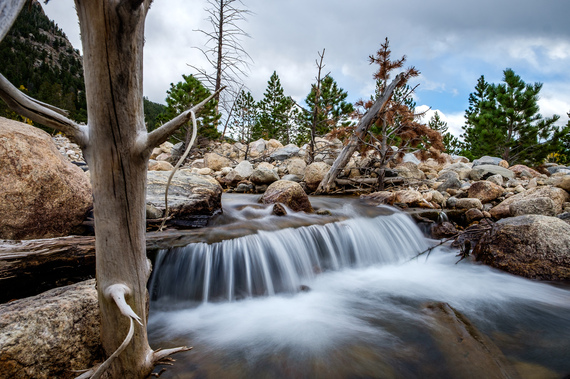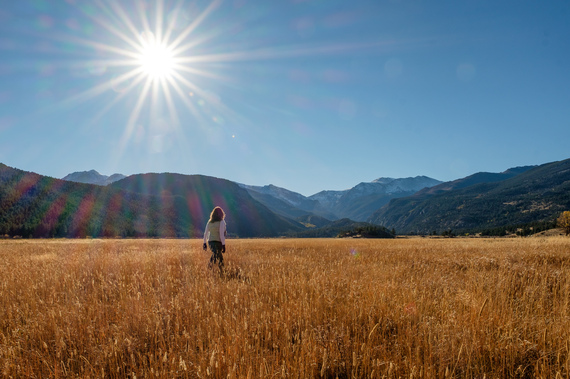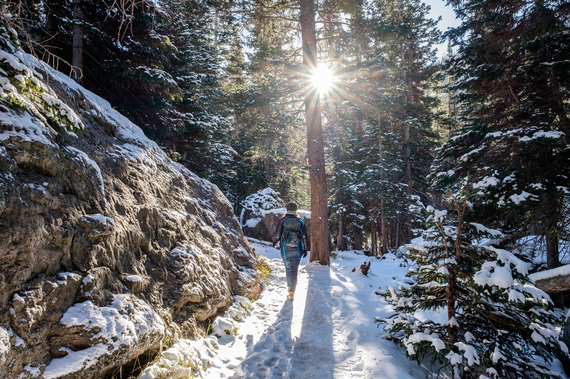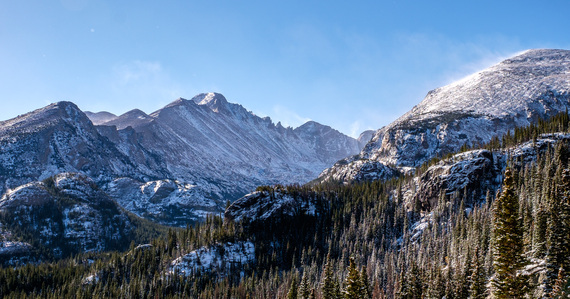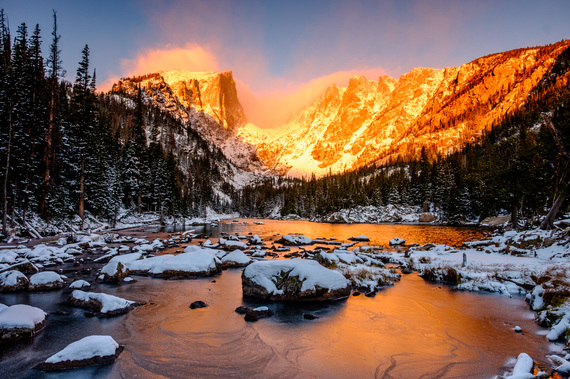
Everyone should visit the Rocky Mountain National Park in Colorado at least once in their lives, if for nothing else than to see some variation of this beautiful scene at Dream Lake... they obviously call it "Dream Lake" for a reason! Photo credit: Jonathan Irish
70 miles northwest of Denver, somewhere between 8,000 and 14,259 feet, exists one of the most comprehensive ecosystems in all of America's national parks - that's not a huge surprise considering the range of natural features born of meadows, forests, lakes, tundra, glaciers, and rugged mountain peaks. It is such diversity that makes Rocky Mountain National Park one of the most actively explored in the system. For the low-key, there are plenty of lazy strolls and leisurely drives to be had; and for visitors who are out there to go bigger - hiking, mountaineering, searching for wildlife, taking photographs, rock climbing, horseback riding and other active adventures are all ready for the grab in Colorado's favorite mountain wilderness. For this article we are going to neck down on some of the aspects of America's 10th national park that made the biggest impression on us when we visited there in early October. We hope that it will help you plan your own trip to the Rockies this year. Enjoy!
Fall Foliage
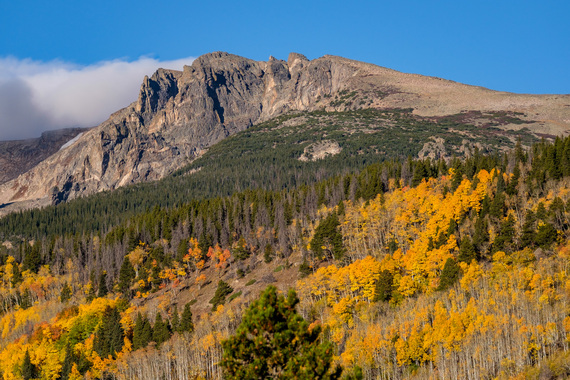
Look no further than Rocky Mountain National Park for some of the most lovely fall foliage in America. Photo credit: Jonathan Irish
Each autumn, colorful bursts of golden, orange, and red leaves decorate white-trunked aspen trees against an evergreen backdrop in Rocky Mountain National Park. The color turn starts in the higher elevations in August, working its way to lower elevations until the last leaf drops in mid-October. The Bear Lake area is a great place to stroll through the foliage on foot, as is the area near Alluvial Fan where there are usually elk herds nearby (making it a really fun place to photograph.) Trail Ridge Road, Old Fall River Road, and Bear Lake Road are three very popular areas to take scenic drives among dense areas of colorful aspen trees during fall foliage. From the high elevation vantage point atop Trail Ridge Road, there are killer marco views of the valley floor.
Elk Rut
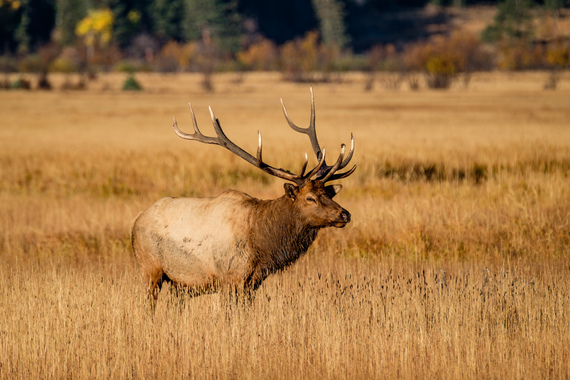
October, mating season for elk, is also known as "Elktober" in Rocky Mountain National Park and the nearby town of Estes Park. :)
Autumn in the Rockies is a beautiful time of year and is a really interesting time to visit. Crowds have thinned from the summer hoards, making way for large herds of elk that can be spotted across vast meadows during their annual breeding season. Dominant males command harems of females while battling other males that get in their way; herding, locking of horns, defiant females... watching their behavior is endlessly fascinating. Mating season is called "rut" which translates from Latin as roar, denoting the call of the bugle that lingers hauntingly across the landscape. In nearby Estes Park, located 11 miles from the park entrance, an annual festival celebrating elk populations in Colorado takes place each year--a sort of Elk-Palooza, with beer gardens, educational programs, and plenty of family-friendly activities.This flurry of activity devoted to the North American elk has earned the month of October the name "Elktober" in the Colorado Rockies.
Landscape Photography
This entire park is photogenic and a beautiful photo can be found pretty much anywhere, however, there are a few key spots that are sure to deliver. At Dream Lake, photographers are blessed with landscape 2.0 moments as they work boulders, forests, mountainous peaks, and whatever the weather decides to offer up that day in terms of color and texture as extras into the frame. This is a great sunrise location but do leave early and bring a headlamp--you'll have to forge a mile trail up hill in the dark to get to the prime spot.
Sprague Lake is an easy place to get to early so you can capture the beautiful Colorado sunrise. A well-beaten walking trail circumnavigates the lake, passing several vantage points from where the mountains rising in the east are in view. On a calm, low-wind day there is an amazing reflection of the Rockies on the water.
A few miles up Trail Ridge Road on the east side of the park there is a wonderful lookout at Many Parks Curve. We had an awesome moment there when the sun burst up over the horizon and lit the entire valley.
Accessible Nature Walks
On the quiet eastern edge of the park is Lily Lake, a peaceful setting and a family favorite as it has an easy 0.8-mile loop trail that is fun for people of all ages with good overall health. Lily Lake was acquired by the National Park Service in 1992 and is a relative newcomer to the park portfolio and is a gorgeous addition.
The hike around Bear Lake is 0.8 miles in length wrapping around a still alpine lake with spruce trees hugging its perimeter. With views of the Rockies in the distance, visitors can get a quick-and-dirty sampling of the unique visual beauty of the area while soaking in the clean mountain air.
Sprague Lake contains 13 acres of pristine mountain water that on a still morning, holds a mirror up to the Rockies. The hike traveling around the lake is 0.9-miles on a flat, well-paved trail with panoramic views of the Continental Divide. The Sprague Lake area has a historic significance too. It was once the location of a homestead built in 1974 by Abner Sprague, an explorer, engineer, mountaineer, and author, who built there a resort where recreational visitors could enjoy the Estes Park area. In 1939, Sprague became the first visitor to pay a park entrance fee.
Hiking
There are 385 miles of maintained hiking trails in Rocky Mountain National Park enabling endless forays into the wilderness on day hikes and multi-day backpacking adventures. The Bear Lake area is the heart of the park with short trails and beautiful sub-alpine scenery. On the west side of the park you can hike to the headwaters of the mighty Colorado River--the waterway that created the Grand Canyon--located at Poudre Pass, 7.5-miles from the trailhead. At the top of Trail Ridge Road, the Ute Trail walks in the tracks of our early ancestors along four miles of alpine tundra. And of course, there is Longs Peak, a bucket list adventure for backcountry climbers seeking sheers rock faces, waterfalls, solitude, and an ultimate challenge.
And don't let seasonality stop you--Rocky Mountain is a wonderful winter playground with endless opportunities to go hiking, bouldering, climbing, mountaineering, skiing, and ice climbing when the temperatures drop.
Note: the base elevation of Rocky Mountain National Park is 8,000 feet; not surprisingly, most hikes will bring you higher than that. Knowing your own limits with altitude and taking time to get acclimatized before setting off on any outdoor adventure will improve your chances of having a great experience. As always, your safety and well being is your own responsibility in our national parks.
Scenic Drives
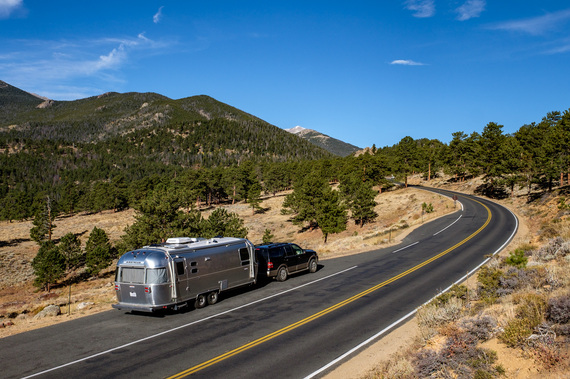
En route to the Aspenglen area of the park with Wally the Airstream in tow. Photo credit: Jonathan Irish.
Trail Ridge Road (U.S. 34) is Rocky Mountain National Park's highway into the sky. It starts in Estes Park on the east side of the Rockies, and ends in Grand Lake on their west side, topping out at 12,183 feet in elevation and crossing the Continental Divide. At this high vantage point, it is just you, the atmospheric rooftop and the Rocky Mountain dreamscape, rich with forests, wildlife, pieces of Earth left behind from the last Ice Age, and seasonable displays of color that decorate the lowlands, sub-alpine area, and tundra.
Built in 1920, Old Fall River Road was the first of its kind in Rocky Mountain National Park, created so that automobiles could travel into higher elevations. It remains more primitive than Trail Ridge Road, and is often referred to by the park as a "motor nature trail." The 11-mile long road has no guard rails and posts a speed limit of 15 miles per hour, so bring your patience with you--and your camera... the intimate nature of this trail provides shelter to plenty of wildlife. The road meets up with Trail Ridge Road at the Fall River Pass.
Two terrific scenic drives!
Mountains
The Rocky Mountain Range is not a long connected chain, but comprised of more than 100 separate mountain ranges, stretching from Canada to New Mexico. Elevation at Rocky Mountain National Park starts at around 8,000 feet, and that is before you start making way to higher elevations--which you will want to do as the views are impeccable. Colorado has more 14'ers (slang for mountain peaks over 14,000 feet) than any other place in the contiguous United States with 53, and to be among mountains so dramatic and massive always inspires awe. With every step you are walking on and near geologic and ecologic processes that span millennia--including the Continental Divide which courses right through the center of the national park. Also called the Great Divide, the feature presents the hydrological divide that sends glacial high-waters into their respective eastern and western directions.
Accessible Location & Cool People
If you live in Denver or the surrounding areas, you can get off work and be in sublime wilderness in just a couple of hours. Many Denver area companies even offer days off after fresh snowfall. Enjoying the wilderness lifestyle is very much a part of the culture of Colorado and it shows by the good vibes from others visiting. In this park, people are just happy to be there and that kind of thing rubs off in the very best way!

